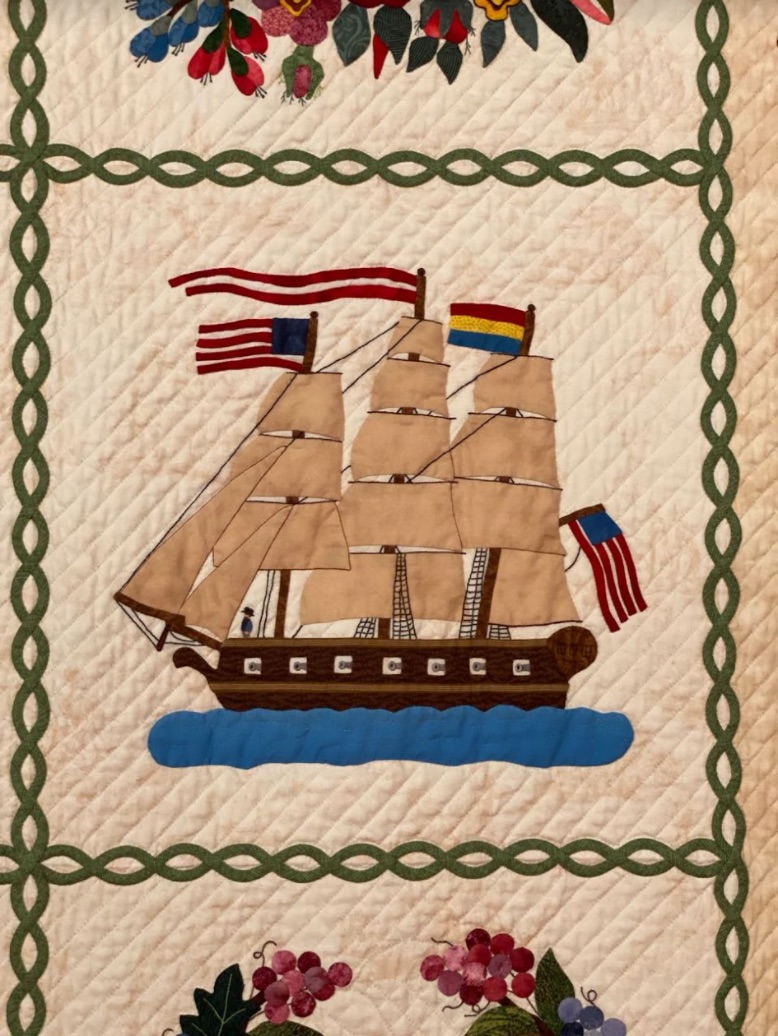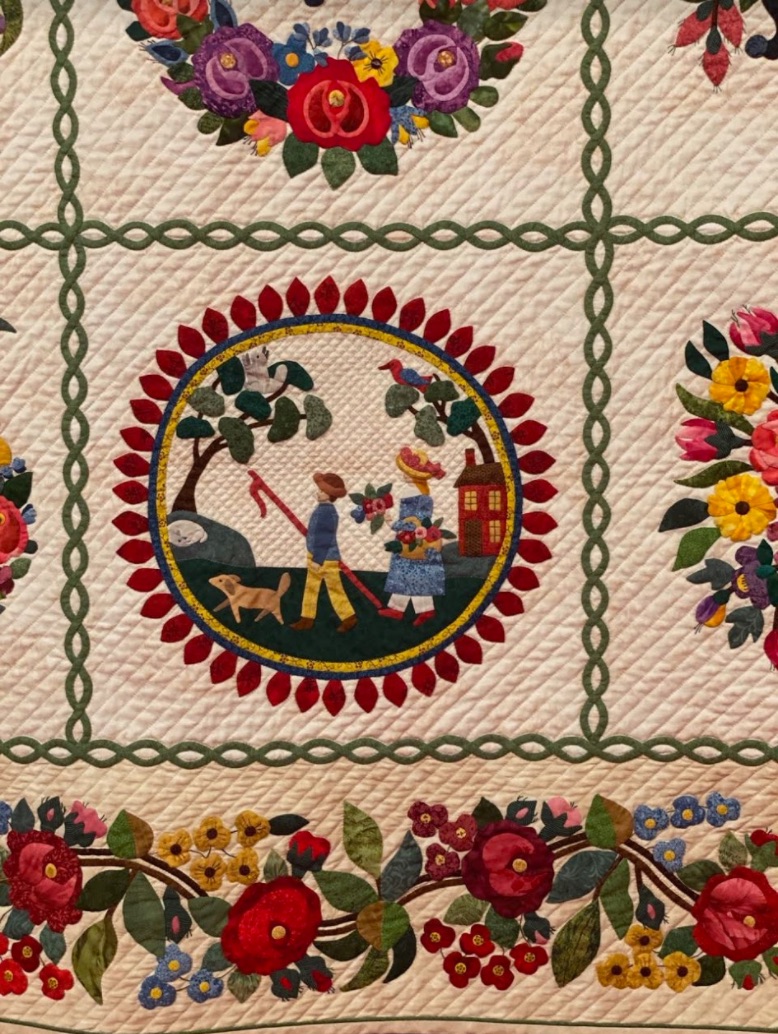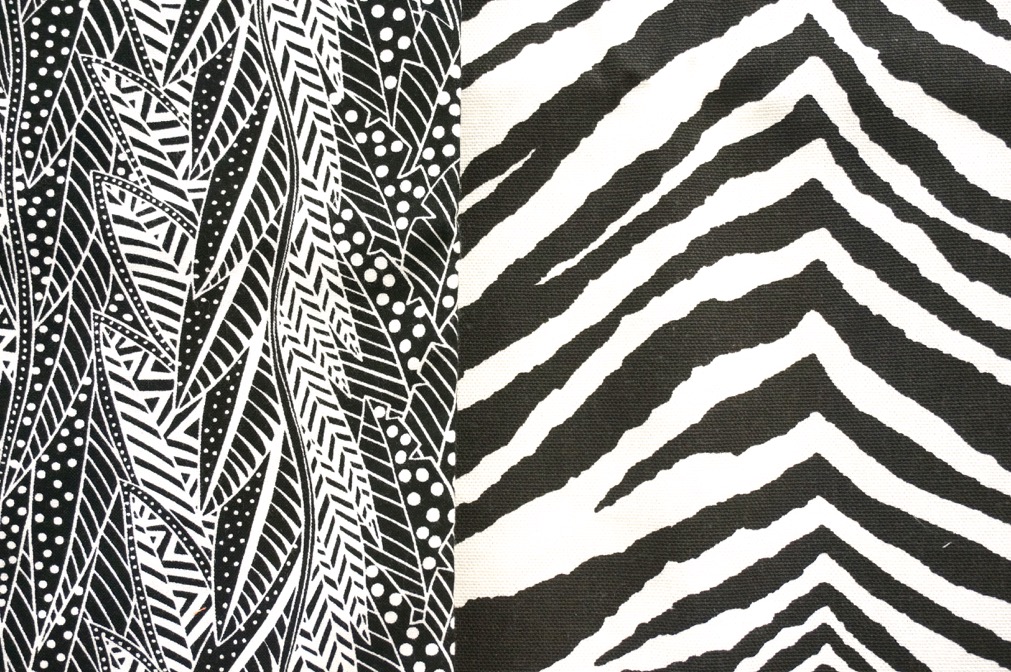Kevin Womack's Tempest features his own hand dyed fabrics and was made to show off the fabric just as much as his quilting skill, that's why the pieces are so large.
Learn From Kevin in Show 2704.

Original Photo: Mary Kay Davis
Kevin Womack's Tempest features his own hand dyed fabrics and was made to show off the fabric just as much as his quilting skill, that's why the pieces are so large.
Learn From Kevin in Show 2704.

Original Photo: Mary Kay Davis
We continue our selection of quilts exhibited in 2019 at the Houston International Quilt Festival as part of their 45th Anniversary, the Sapphire Anniversary. The Sapphire Celebration exhibit is described as:
"Quilters have long used the color blue to symbolize trust, loyalty, wisdom, confidence, intelligence, faith, truth, and heaven. Sapphire is also the chosen gem to celebrate 45th anniversaries—which International Quilt Festival is doing this year (2019)! These new and antique blue and white quilts will be suspended from the ceiling in a spectacular and unforgettable display."
To be a part of the exhibit, quilts had to fit the following criteria:
Please enjoy the twenty-sixth quilt from the exhibition by an Unknown Maker.
Title of Quilt: Goose in the Pond
Quilter's Name: Unknown Maker


Donna Gilbert dedicated her quilt, When This You See Remember Me, to those she lost in the five-year journey it took to make. Donna used her love of the Baltimore Album design to express her feelings throughout the quilt.
When This You See Remember Me by Donna Gilbert of Chambersburg, Pennsylvania was featured in the Appliqué, Large category at Houston 2019.







The San Jose Museum of Quilts & Textiles presents Tribute to the Civil Rights Movement: Quilted Swing Coats by Patricia A. Montgomery.
From the Museum:
Join us for an artist talk with Oakland-based artist Patricia Montgomery, who will discuss her important series Tribute to the Civil Rights Movement: Quilted Swing Coats. The Civil Rights Movement, led by African Americans who used nonviolent civil disobedience actions, transformed the United States and became a catalyst for other national and international civil disobedience protests that followed. This series recognizes and celebrates the many African American women who made major contributions to the Civil Rights Movement in the form of story quilts created in African American traditional quilting design and construction techniques. Each quilt is structured in the shape of a swing coat that illustrates these women’s individual stories and historical impact.
This is a recorded video of that talk.
Christa Watson, quilter, teacher, fabric designer, and more, gives you a tour of her home studio. She has some great ideas for organization and wait until you see the "store" she has at home. You'll wish your guest bedroom looked the same.
Learn more from Christa in Show 2409 and see how she created her design wall.
Leni Levenson Wiener says, "I used to always joke that my quilts got to travel to more exciting places than I do..." In this case, it might be true. Leni's quilt, Icy Perch, was exhibited at TIQE – Taiwan International Quilt Exhibition 2012.
Star members can watch Leni in Show 1413: From Film to Fabric: Photos as Inspiration and Show 2204: The Human Form from Portrait to Art Piece.

In this lesson of The Art of Quilt Design program, we shift our focus to look at Unity. In it's most basic terms, Unity can be thought of as, everyone in a group working together. Unity represents calmness and order through repetition, either by shape or color. It can be achieved with pattern, color or theme.
Let's use the example of a quilt guild annual quilt show. Such a project requires many entries. Everyone in the guild is encouraged to include a quilt that will, of course, be displayed. Quilts on display will fall into various categories (e.g. Traditional, Contemporary, Art, Mixed Media, etc.) and due to the exhibit space may only be between the sizes of A-B inches high and Y-Z in width.
As quilts are dropped off at a designated location, workers begin the monumental task of sorting. You know the drill. You might have even helped with your local guild quilt show set-up. All of the traditional quilts are place on the left, all the contemporary one's on the right, and so on...until all of the quilts have a resting place. Quilts are then hung by group in their pre-designated areas. By presenting all of one grouping together, it offers the show attendee a unified and harmonious view. All the traditional quilts play well together, in one area while the contemporary quilts play equally well in theirs. It is this unity that makes for a sense of harmony.

In this example notice how all of the droplets on the left are the same color, but different sizes. In the area on the right all of the droplets are a different color, but the same size.
Now that you understand the ways that you can create Unity, let's look at some excellent examples of quilts.


Fill the Void by Cinzia Allocca. (image QuiltCon) i Quilt by Kathy York. (image QuiltCon)


Dream Catcher by Kathy Doughty (Show 2303). [image TheQuiltShow]. Circle Game by Kathy Doughty (Show 2309). [image TheQuiltShow]


Farm Market Blooms by Nancy Simmons. (image AQS). Bubble Ballet by Birgit Schueller. (image AQS)


Tranquil Spaces by Loretta Painter. (image AQS)
Forca Barca by Rosa Rojas and OlgaGonzales. (image TheQuiltShow)
Ann P. Shaw shares how she auditions fabric for a quilt from start to finish when looking to create maximum visual Unity by incorporating a variety of the same type of fabric.
(images by Ann P. Shaw, unless otherwise noted)

Fabric selections are a good way of creating unity with variety in a quilt design. Often, when we think about fabrics for a quilt, we choose a few colors that blend or select thoughtfully coordinated colors and prints. And when we run out of some particular fabric have way through a project, it can lead to a desperate search for another yard of the same fabric to complete the quilt.
For many of my quilts, I like to think broadly about how different printed fabrics can have a very similar visual impact. This is a good way to expand one’s use of fabrics and develop a richer look to one’s quilts.
My quilt, Grant’s Zebra, is a good example of creating unity from variety in my fabric selections. I love Zebras and I’ve seen many wonderful zebra quilts where individual black fabric pieces are appliquéd or fused onto the white body of the zebra to create its stripes. However, I thought it would be an interesting challenge to create a pieced zebra quilt where the fabrics did the design work without having to piece each individual stripe. That meant I would need to carefully consider the black and white printed fabric I would use. In this case, different fabric choices, each with some kind of black and white stripy print would help create the overall look of the zebra.


I started pulling black and white prints from my stash and found a zebra print (Image on the left). Perfect, but the scale of my other zebra prints was too small (Image on the right). Besides, I knew that using other kinds of prints would add spark to the overall look of the quilt.


Some prints had swirls or dots or leaves, but didn’t provide the look of a zebra (Image on the left). Other prints had a stripy look, but had too much black (Image on the right).

As I began winnowing down my choices, I focused on stripy-like prints, and found several prints that were the right large scale.



I then experimented with the placement of each print, using the largest print in the neck of the zebra (Image middle) and smaller prints around the eye (Image far right). The trick was to use prints that had a stripped look and had similar amounts of white (or cream) background. I also liked that some of the prints had little bits of other colors (even lime green, my favorite color!) that helped break up the mass of black and white.
To create unity from variety in a quilt design, identity printed fabrics that:
Click here for more topics related to The Art of Quilt Design program
Sharon Smith is fascinated by circles. Her quilt, Untitled, is filled top to bottom with variations of them. From the appliqué to the quilting designs, how many circles can you find?
Untitled by Sharon Smith of DeKalb, Illinois was featured in the Appliqué, Small category at Houston 2019.



Lisa Walton, textile artist and past President of SAQA, talks to QuiltCon winner Tara Glastonbury, who shares the story and inspiration behind her quilt, Handloomed.
You can watch Lisa here at TQS in Show 2503.
Alex is going to show how to make the Dutchman's Puzzle Quilt Block. This is such a fun block that you may end up making an entire quilt featuring it. And wait until you see what happens when you put more than one block together...we love secondary surprises.
Watch Alex LIVE on Wednesday, August 12, 2020 at 10AM Pacific, 11AM Mountain, Noon Central, 1PM Eastern, and 6pm London.